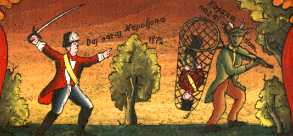The bear and the bees – more Slovenian bee-houses
- Complaining about the Mainland - 17th August, 2024
- New island designation – is it just greenwash? - 26th April, 2024
- Police and Crime Commissioners – a solution or a problem? - 21st April, 2024
If you read The Ranger’s recent post about Slovenian bee-houses you must have shared his frustration at not to be able to see more detail of the exquisite little pictures painted on these traditional hives. Help is at hand from the interesting Virtual Beekeeping Gallery. The site has a bit more information about the bee-houses (looks like it has been translated, but it’s so charmingly written there’s no need to correct it):
They were decorating the small front borards over the gullet with different little pictures depictings Saints, people and animals and especially from everyfay lige. The contents of the pictures on the beehive box endind is sometimes religious, sometimes educational but evry often also both humoristic and satirical. Today we cannot definit exactly when the first beehive endings were made and we can only guess as to the cause of such a sort of paintings. We do know that the first dated beehive ending origantes from the year 1758. Ubfurtubately most of them in the passage of time were lost, partly beacuse people did not know to appreciate their historical and documentary value
As well as providing a great deal of bee-keeping information in many languages, the Virtual Beekeeping Gallery has a small gallery of images from the bee-houses – here’s a sample:

The Ranger also found another website with more bee-house information, and some more nice pictures. Pcela.co.yu seems to back up The Ranger’s theory about bee orientation, and add another helpful function to the list:
These beehives are called “kranjiči” (Carniolans). A small wooden bee house was built in the sheltered part of an orchard. So honey bee colonies were kept under one roof, protected from snow and cold in winter and sweltering heat in summer. Thanks to certain advantages, such bee houses are still very popular in Slovenia today and contribute to the cultural image of the landscape. In the mid 18th century, a unique folk art, the painting of beehive fronts, began to emerge in the territory of Slovenia… These can still be admired today in the Museum of Apiculture in Radovljica. Simple bee houses became true open-air art galleries… depicting historical and biblical events, as well as everyday village life. Because of these painted bee hive fronts the bees were able to orient themselves more easily, and the beekeeper was able to distinguish among the beehives better. This help him to remember which bee colony had already swarmed.


Alas, that’s as good as it gets. I have no better picture than that – I wish I did!
Could you provide with a better picture of the lower beehive end? I think I can explain you the story behind that one but I need the words to be sure.
My son is visiting Slovenia this weekend. I love the beehive box endings paintings and would like him to get one for me. Any idea of the cost? I’ve searched and found nothing.
The Ranger responds: I don’t even know if they can be bought, although I’d be surprised if not. Let’s hope your son finds one, let us know if so!
Slovenian bee house pictures much appreciated and forward to one or two beefreaks for interest